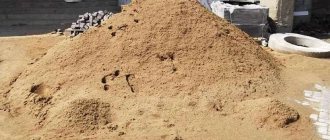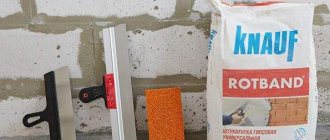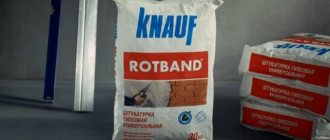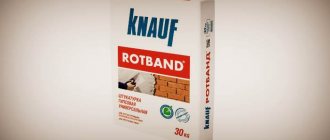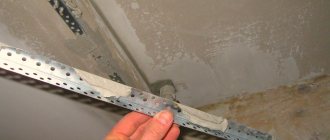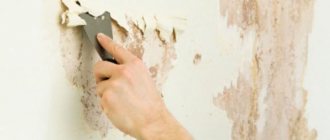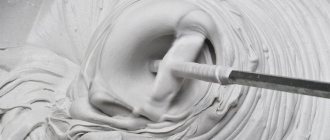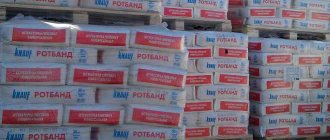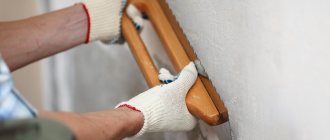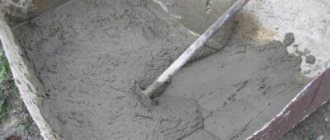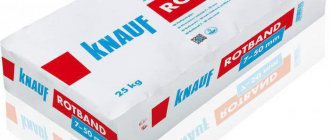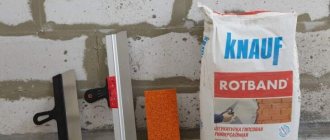Knowledge of how to make rotband will be needed not only for those beginners who use Knauf products, but also for anyone who has chosen gypsum compounds from other manufacturers for manual plastering of walls and ceilings. To dilute plaster mixtures with a gypsum base correctly, you need to know the nuances, which we outline using the example of Rotband Knauf. This dry mixture (SS) is universal; it can be used to level not only walls, but also ceilings.
Can plaster be mixed by hand?
If you don’t have a special tool at hand, you can spread the putty manually
. This method is applicable for preparing a starting coating, which is not particularly demanding on the mixing method. For this, use an ordinary bucket or other container without rounded corners.
Interesting materials:
How to line the inside of a bathhouse with clapboard? How to cover OSB walls correctly? How to properly sheathe an iron door? How to wear the L1 suit correctly? How to wear a combined arms protective kit correctly? How to wear a duvet cover correctly? How to properly plaster a ceiling? How to fatten pigs correctly? How to steam clothes with an iron? How to properly saw off the baseboard in the corners?
Tools and containers
First, we will list the tools and accessories, then we will analyze the details.
You will need:
- Master OK;
- mixer;
- spatulas (2 different widths);
- containers (for mixing, water, washing tools);
- wide brush for washing tools and dishes;
- scales, measuring container.
Let us immediately note several nuances of the mixing process related to the container. Today's utensils are made of plastic. A container made of soft plastic will withstand numerous cycles of mixing and production longer.
The container volume is selected depending on the number of plasterers directly involved in applying the plaster, their experience, as well as the volume of mass required for repairs. If you only need to plaster a small area, you can use a plastic paint bucket for preparation. If a beginner is plastering, then a 60 liter basin is enough. A professional will be able to produce a large volume (90 liter container) before setting begins.
In order for a plastic basin to last longer, it is recommended not to carry it along the floor, but to rearrange it by lifting it (it is advisable to take it together, then the container will not deform under the weight of the plaster when lifted).
You can also strengthen the walls of the pelvic bowl by wrapping it with several layers of tape.
Before mixing, the floor surface under the basin is cleared of debris (must be level), and near the wall it is better to place a basin filled with solution on a bag with SS.
Gypsum is a capricious material and sets quickly. The lifespan of a solution may vary for various reasons. If a lump of the solution that has begun to harden gets into the plaster dough, crystallization centers will form ahead of time. For this reason, you cannot add dry mixture to a ready-made solution.
Current recommendations
To ensure that the plaster solution turns out to be of high quality and there are no problems with its use, it is recommended to adhere to the following current tips:
— you cannot add water or powder concentrate to the prepared mixture during plastering work;
— leaving the solution “for later” is prohibited. It will quickly harden or begin to clump - both processes make the mass unsuitable for further use;
— it is necessary to follow safety precautions and precautions when using electrical appliances (mixer, hair dryer, drill) when working with plaster;
— you need to wear protective equipment: gloves, thick clothing, goggles, a respirator, appropriate shoes.
Good luck with your work and ideal results on plastered surfaces!
Additional components
Manufacturers often add special components to their ready-made mixtures, which increase the ductility and strength of the material and add moisture-repellent properties to it. The following additional components are often used :
- Lime (lime paste). Increases plasticity and makes the material moisture-proof. The proportions of lime to cement are 1:2. The additional component cannot be larger than the main component. Lime is added only to mixed cement and sand.
- Clay . Increases plasticity and makes the material moisture-proof. Clay is added at the rate of 50-100 g per 15 liters of water. To prevent the formation of lumps in the solution, the clay is first ground in a small amount of water to form a cloudy liquid. The component is then added to the dry mixture.
- Detergent (liquid soap, washing powder, etc.). Increases plasticity and adhesion. The amount of product should not exceed 3% of the total mass.
- PVA glue . Increases ductility and increases service life. The volume of the added component should not exceed 3% of the total mass of the mixture.
Fillers
Fillers are divided into:
- natural (river and quarry sand, stone chips, gravel);
- artificial (expanded clay sand, sawdust, fuel slag).
Sand is the best filler; the finer it is, the higher the quality of the solution, in general. The use of sand with a fraction of up to 0.5 mm makes it possible to obtain smooth surfaces that do not require additional putty before finishing the surfaces.
It is preferable to use river sand; it does not require washing, unlike quarry sand, which may contain a large percentage of clay.
( 2 ratings, average 5 out of 5 )
Preparation of plaster mortar
The topic of preparing plaster mortar has become relevant, since in the previous article we installed the first plaster beacon and used plaster mortar to fix it, so you should know how to prepare it now. And then this solution will be needed for the main leveling of the walls.
One of the main principles of preparing plaster mortar is that you do not need to immediately dilute the entire bag in a large bucket. The fact is that the plaster dries quite quickly. If you dilute a large volume at once, then you will have time to work with the first part of the solution, but the remaining part will harden and you will simply throw away the material. Therefore, dilute the plaster in small portions: 3-4 kg of dry mixture and mix it with water. We worked, the solution ran out, a new one was prepared, and so on. You need to work quickly enough, because hardening occurs within 20 minutes.
So, what do we need to prepare the plaster solution?
Tools
For work we take the following tools:
- electric drill;
- mixer - attachment for an electric drill;
- water measure;
- a bucket for plaster poured from a bag;
- steelyard for weighing plaster poured from a bag;
- bucket (basin) for the finished solution.
Materials
The materials will only be:
- Rotband plaster;
- water.
The process of preparing the solution
Now let's take a closer look at the process itself:
- Open the bag of plaster.
- Pour some of the plaster from the bag into a bucket (about 3-4 kg). For accuracy, we take a steelyard and weigh the dry mixture minus the weight of the bucket itself (for example, 3 kg).
- We calculate how much water we need to take for 3 kg of dry mixture. If you read the instructions on the Rotband packaging, we will see the following:
For 10 kg of dry construction mixture you need to take 6-7 liters of water. Let's take the average: 6.5 liters.
And then, simply, as in a school mathematics course using the rule of proportion:
10 kg - 6.5 liters
X=6.5*3/10 =1.95 liters of water
Thus, for 3 kg of dry mixture you need about 2 liters of water.
- We take a water measure and use it to measure out 2 liters of water and immediately pour this water into a bucket (basin) for the future solution.
- Take an electric drill and install the mixer. We check that the electric drill is working and the mixer is rotating.
- Take a bucket filled with dry plaster and pour it into a bowl of water.
- Immediately take a drill with a mixer installed, turn it on and begin mixing the dry mixture with water. You can read how to use a drill with a mixer in the article: Impact drill. Functions, operating modes, application. You can also download my book about the impact drill, which describes in great detail the many functions of this wonderful tool. In general, mixing plaster with water with a mixer is somewhat reminiscent of beating dough. Therefore, if you did something similar in the kitchen, then there is nothing difficult about it.
- You need to stir until the solution takes the form of thick sour cream. If we take our volume, then it is about 2 minutes.
- Next, after mixing, you need to wait 5 minutes and mix again. That's it, after this the plaster solution is ready for use.
- After the solution is ready, you need to take part of it with a trowel or trowel, throw it on the wall and begin the leveling process, which I will, of course, tell you about.
It doesn’t matter whether you mix the mixture yourself or you ordered the work from a master, but there is an important point that will, of course, ensure ease of work. Read about it here: Small repair tips will also come in handy
Instructions for use
Rotband is a gypsum-based plaster from the Knauf brand. The composition includes high-strength gypsum and minerals that are used for strengthening. The product is produced in paper bags in dry form.
Rating of popular dry mixtures for plastering walls.
Before use, the plaster must be diluted with water to obtain a mixture for surface treatment. It is important to maintain the proportions and stir until smooth so that there are no lumps, otherwise when puttingtying the walls or ceiling the material will lie unevenly.
Analogues. What's better?
It is worth noting that there are several types of gypsum-based dry plaster on the construction market. Therefore, if you wish, you can choose a good alternative to Rotband. However, how feasible would such a replacement be? To answer this question, you need to compare the characteristics of the most popular plaster mixtures.
"Volma" or "Rotband"
If we talk about technical characteristics, there is no significant difference between the mixtures. At the same time, Volma is much cheaper, which promises financial benefits for large volumes of work. In addition, “Rotband” is often counterfeited, so even at a high price you can buy a low-grade counterfeit.
"Teplon" or "Rotband"
Comparing these mixtures, you can notice the difference in price: “Rotband” will cost significantly more. At the same time, the consumption of "Teplon" looks more economical - 4.5 kg/m2 . In terms of quality, “Rotband” looks more attractive, so if your budget allows, it is better to give preference to this particular plaster.
"Goldband" or "Rotband"
The mixtures are produced by the same company, so they have no fundamental differences in price and quality. However, in the field of application the difference becomes noticeable. In particular, Rotband has better adhesion, so it can be used to level rough and smooth surfaces. The analogue does not have this feature, therefore it is used only for rough walls, which initially provide high adhesion of materials.
In general, “Rotband” can be replaced with an analogue, especially if the issue of price plays a decisive role.
How to breed rotband in small quantities
If you need to dilute just a little solution, remember about HCV (see above). We measure the calculated (according to the proportion) volume of water. Using scales, we prepare the amount of SS that will be sufficient. The cooking process is similar to that described. The container can also be taken in a smaller volume.
Example:
It is required to plaster an area of 2 sq.m., 1.5 cm thick. On the packaging (30 kg) we read that the yield of the finished product is 40 liters. Rotband SS consumption per square meter is 8.5 kg. This is with a layer thickness of 10 mm. Therefore, to cover 1.5 cm per square you will need 8.5 x 1.5 = 12.75 kg, and for two squares - 25.5 kg. Taking into account HCV: 25.5 x 0.64 = 16.32 liters of water (remember that some water needs to be poured in reserve).
There is a small nuance. The container should hold the required amount of solution. Taking into account the fact that during mixing the gypsum mass increases in size, the container is selected such that the poured water occupies no more than half of the internal volume. Preferably a third.
As an option (in case of low consumption): gypsum plaster can be diluted even in half a rubber ball.
